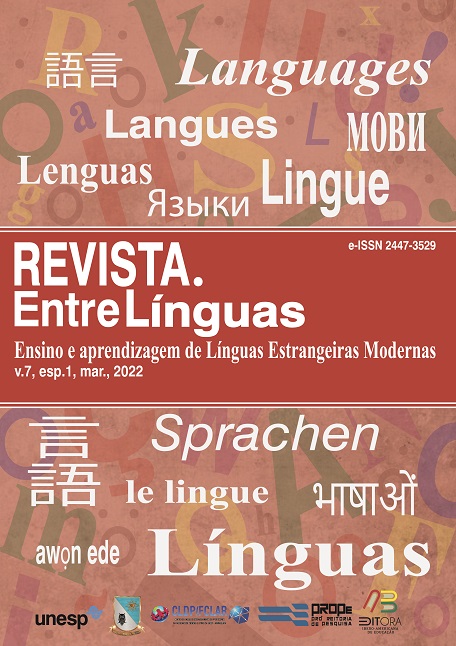O vocabulário do coronavírus como meio de refletir o conhecimento sobre uma pessoa
DOI:
https://doi.org/10.29051/el.v8iesp.1.16919Palavras-chave:
Representação do conhecimento sobre uma pessoa, Conceitos de oposição, Vocabulário russo sobre o coronavírus, Nomes de pessoas, Formação de palavrasResumo
O artigo examina o conhecimento sobre uma pessoa que é representado por unidades de linguagem criadas durante a pandemia do coronavírus. Essas unidades linguísticas são formadas por métodos como composição de palavras, afixação, fundamentação e combinação e compõem três categorias lexicais “doentes de coronavírus”, “cidadãos que cumprem as regras antiepidemiológicas” e “violadores das regras antiepidemiológicas”. Descrevem-se as características dos conceitos representados pelas unidades de linguagem dessas três categorias, mostra-se que os conceitos transmitidos pelas unidades de linguagem das categorias "cidadãos cumpridores da lei que observam as regras antiepidemiológicas" e "violadores das normas antiepidemiológicas regras" pode ser considerado como de oposição. É dada especial atenção à análise dos componentes usados na composição de palavras e afixos, com a ajuda dos quais são criadas unidades derivadas.
Downloads
Referências
AKUT, K. B. Morphological Analysis of the Neologisms during the COVID-19 Pandemic. International Journal of English Language Studies, v. 2, n. 3, p. 1-7, 2020. Available in: https://al-kindipublisher.com/index.php/ijels/article/view/90. Access in: 26 Jan. 2021.
ASIF, M. et al. Linguistic analysis of neologism related to coronavirus (COVID-19). Social Sciences & Humanities Open, v. 4, n. 1, 100201, 2021. Available in: https://www.sciencedirect.com/science/article/pii/S2590291121000978?via%3Dihub. Access in: 20 Jan. 2021.
BURRIDGE, K.; MANNS, H. ‘Iso’, ‘boomer remover’ and ‘quarantini’: How coronavirus is changing our language. The Conversation, 2020. Available in: https://theconversation.com/iso-boomer-remover-and-quarantini-how-coronavirus-is-changing-our-language-136729. Access in: 07 Feb. 2021.
BUTSEVA, T. N.; ZELENIN, A. V. Lexicography in the situation of neological extreme (based on the material of neolexics associated with the coronavirus pandemic). Bulletin of Cherepovets State University, v. 6, n. 99, p. 86-105, 2020. Available in: https://www.elibrary.ru/item.asp?id=44387469. Access in: 27 Jan. 2021.
CATERMINA, V. V.; LIPIRIDI, S. H. Features of displaying the coronavirus pandemic in the vocabulary of medical discourse (based on English neologisms). Izvestiya Volgograd State Pedagogical University, v. 4, n. 147, p. 170-175, 2020. Available in: https://www.elibrary.ru/item.asp?id=42882761. Access in: 10 Feb. 2021.
DICTIONARY OF THE RUSSIAN LANGUAGE OF THE CORONAVIRUS ERA. Saint Petersburg: Institute of Linguistic Research of the Russian Academy of Sciences, 2021.
GEKKINA, E. N. Covid versus coronavirus: from observations of regular cases of derivational differences. In: SERGEEVNA, G. E.; SERGEEVNA, P. A.; NIKOLAEVNA, P. M. (eds.). New words and dictionaries of new words. Saint Petersburg: OR RAS, 2020.
GRISHKINA, E. N. The problem of correlation between the concepts of "neologism" and "new word" (psycholinguistic aspect). Yekaterinburg: Ural Federal University, 2016.
KHALFAN, M.; BATOOL, H.; SHEHZAD, W. Covid-19 Neologisms and their Social Use: An Analysis from the Perspective of Linguistic Relativism. Linguistics and Literature Review, v. 6, n. 2, p. 117-129, 2020. Available in: https://papers.ssrn.com/sol3/papers.cfm?abstract_id=3819563. Access in: 22 Jan. 2021.
MAP OF WORDS AND EXPRESSIONS OF THE RUSSIAN LANGUAGE. Kartaslov, n.d. Available in: https://kartaslov.ru. Acesso em: 11 Feb. 2021.
MINEEVA, Z. I. Neoderivaty in the Russian language of the pandemic era, In: New words and dictionaries of new words. In: SERGEEVNA, G. E.; SERGEEVNA, P. A.; NIKOLAEVNA, P. M. (eds.). New words and dictionaries of new words. Saint Petersburg: OR RAS, 2020.
MITURSKA-BOJANOVSKA, Y. Word-formation contamination in the era of coronavirus (based on colloquial speech and newspaper headlines). In: SERGEEVNA, G. E.; SERGEEVNA, P. A.; NIKOLAEVNA, P. M. (eds.). New words and dictionaries of new words. Saint Petersburg: OR RAS, 2020.
MOSKALEVA, M. V. Neologisms and the problem of their study in modern Russian. Proceedings of Herzen Russian State Pedagogical University, v. 80, p. 246–250, 2008. Available in: https://cyberleninka.ru/article/n/neologizmy-i-problema-ih-izucheniya-v-sovremennom-russkom-yazyke. Access in: 9 Jan. 2021.
PAVLOVA, A. S. The names of the COVID-19 coronavirus infection in Russian, English and German: cultural and national specifics. In: SERGEEVNA, G. E.; SERGEEVNA, P. A.; NIKOLAEVNA, P. M. (eds.). New words and dictionaries of new words. Saint Petersburg: OR RAS, 2020.
SAVCHENKO, A.V.; YAN-JUN, L. “Coronavirus neologisms”: From vocabulary and phraseology to Internet memes (based on the material of Russian and Chinese). Communicative research, v. 7, n. 4, p. 865-886, 2020. Available in: http://com-studies.org/images/magazine/2020/KI_4_2020.pdf. Access in: 19 Feb. 2021.
ZELENIN, A. V.; BUTSEVA, T. N. From sididomites to coronapophigists (Names of persons during the coronavirus pandemic). Russian language at school, v. 81, n. 6, p. 97-106, 2020. Available in: https://www.riash.ru/jour/article/view/1433. Access in: 24 Jan. 2021.
Downloads
Publicado
Como Citar
Edição
Seção
Licença

Este trabalho está licenciado sob uma licença Creative Commons Attribution-NonCommercial-ShareAlike 4.0 International License.
Os manuscritos aceitos e publicados são de propriedade da Revista EntreLínguas. Os artigos publicados e as referências citadas na Revista EntreLínguas são de inteira responsabilidade de seus autores.
Transferência de direitos autorais – autorização para publicação
Caso o artigo submetido seja aprovado para publicação, já fica acordado que o(s) autor(es) autoriza(m) a UNESP a reproduzi-lo e publicá-lo na EntreLínguas, entendendo-se os termos “reprodução” e “publicação” conforme definição respectivamente dos incisos VI e I do artigo 5° da Lei 9610/98. O artigo poderá ser acessado pela rede mundial de computadores (Internet), sendo permitidas, a título gratuito, a consulta e a reprodução de exemplar do artigo para uso próprio de quem a consulta, desde que haja a citação ao texto consultado. Essa autorização de publicação 328 EntreLínguas, Araraquara, v. 1, n .2, p. 323-328, jul./dez. 2015 não tem limitação de tempo, ficando a UNESP responsável pela manutenção da identificação do(s) autor(es) do artigo. Os artigos publicados e as referências citadas na Revista EntreLínguas são de inteira responsabilidade de seus autores.











